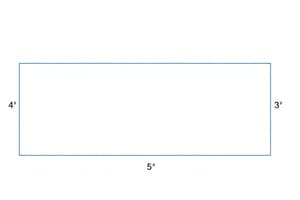Podcast
Questions and Answers
What is the formula for the area of a parallelogram?
What is the formula for the area of a parallelogram?
- Base × Height (correct)
- Length + Breadth
- Length × Height
- Base + Height
The area of a parallelogram is equal to the area of a rectangle formed when it is split along its height.
The area of a parallelogram is equal to the area of a rectangle formed when it is split along its height.
True (A)
What do you call the perpendicular line dropped from a vertex to the opposite side in a parallelogram?
What do you call the perpendicular line dropped from a vertex to the opposite side in a parallelogram?
Height (or altitude)
The area of a parallelogram is calculated as the product of its base and _____ .
The area of a parallelogram is calculated as the product of its base and _____ .
Match the following terms with their definitions:
Match the following terms with their definitions:
If the base of a parallelogram is 10 cm and its height is 5 cm, what is its area?
If the base of a parallelogram is 10 cm and its height is 5 cm, what is its area?
Any side of a parallelogram can be chosen as the base for calculating the area.
Any side of a parallelogram can be chosen as the base for calculating the area.
Describe how a parallelogram can be transformed into a rectangle.
Describe how a parallelogram can be transformed into a rectangle.
What is the formula for the area of a triangle in relation to the area of a parallelogram?
What is the formula for the area of a triangle in relation to the area of a parallelogram?
The height of a triangle is always located inside the triangle itself.
The height of a triangle is always located inside the triangle itself.
If the base of a parallelogram is 6 cm and its height is 4 cm, what is the area of the parallelogram?
If the base of a parallelogram is 6 cm and its height is 4 cm, what is the area of the parallelogram?
The area of a parallelogram is equal to the product of its base and ______.
The area of a parallelogram is equal to the product of its base and ______.
Match the triangle types with their properties:
Match the triangle types with their properties:
Which of the following statements about congruent triangles is correct?
Which of the following statements about congruent triangles is correct?
Two triangles can have the same area but still be congruent.
Two triangles can have the same area but still be congruent.
What can be said about the triangles formed by cutting a parallelogram along its diagonals?
What can be said about the triangles formed by cutting a parallelogram along its diagonals?
What is the perimeter of each semicircular shape disc with a radius of 7 cm?
What is the perimeter of each semicircular shape disc with a radius of 7 cm?
The circumference of a circle is always greater than its diameter.
The circumference of a circle is always greater than its diameter.
What is the diameter of a circle with a radius of 7 cm?
What is the diameter of a circle with a radius of 7 cm?
The circumference of a semicircle with a radius of 7 cm is _____ cm.
The circumference of a semicircle with a radius of 7 cm is _____ cm.
Match the term to its corresponding value:
Match the term to its corresponding value:
What formula is used to calculate the circumference of a semicircle?
What formula is used to calculate the circumference of a semicircle?
The total perimeter of the given figure is 88 cm.
The total perimeter of the given figure is 88 cm.
If a farmer wants to cover an area with radius 7 m, how many kilograms of fertiliser does he need?
If a farmer wants to cover an area with radius 7 m, how many kilograms of fertiliser does he need?
What is the formula for the area of a circle?
What is the formula for the area of a circle?
The circumference of a circle is calculated using the formula $2πr$.
The circumference of a circle is calculated using the formula $2πr$.
What is the area of a circular table-top with a radius of 2 m at the rate of ₹10 per square meter?
What is the area of a circular table-top with a radius of 2 m at the rate of ₹10 per square meter?
The area of a circle can be found by using the formula __________.
The area of a circle can be found by using the formula __________.
Match the following shapes to their calculations:
Match the following shapes to their calculations:
If the radius of a circle is doubled, how does the area change?
If the radius of a circle is doubled, how does the area change?
The diameter of a circle is twice the radius.
The diameter of a circle is twice the radius.
What is the area of a circular garden with a diameter of 9.8 m?
What is the area of a circular garden with a diameter of 9.8 m?
What is the formula to find the area of a parallelogram?
What is the formula to find the area of a parallelogram?
The area of triangle with base 8 cm and height 5 cm is 20 cm².
The area of triangle with base 8 cm and height 5 cm is 20 cm².
What is the height of a triangle if the base is 10 cm and the area is 50 cm²?
What is the height of a triangle if the base is 10 cm and the area is 50 cm²?
The area of a parallelogram with a base of _____ cm and a height of 6 cm is 84 cm².
The area of a parallelogram with a base of _____ cm and a height of 6 cm is 84 cm².
Given that the area of parallelogram PQRS is calculated with height QM = 7.6 cm and base SR = 12 cm, what is the area?
Given that the area of parallelogram PQRS is calculated with height QM = 7.6 cm and base SR = 12 cm, what is the area?
The area of triangle ABC is equal to 30 cm² when the base is 15 cm and the height is 4 cm.
The area of triangle ABC is equal to 30 cm² when the base is 15 cm and the height is 4 cm.
The area of triangle with a base of 22 cm and height of _____ cm is 170.5 cm².
The area of triangle with a base of 22 cm and height of _____ cm is 170.5 cm².
What is the area of the larger circle with a radius of 10 cm?
What is the area of the larger circle with a radius of 10 cm?
The radius of the smaller circle in the example is 3 cm.
The radius of the smaller circle in the example is 3 cm.
Calculate the area of a circle with a diameter of 49 m using π = 3.14.
Calculate the area of a circle with a diameter of 49 m using π = 3.14.
The area of the shaded region between the two circles is ___ cm².
The area of the shaded region between the two circles is ___ cm².
Match the following circles with their respective areas:
Match the following circles with their respective areas:
If the circumference of a circular sheet is 154 m, what is its radius? (Take π = 22/7)
If the circumference of a circular sheet is 154 m, what is its radius? (Take π = 22/7)
To fence a circular garden of diameter 21 m, the gardener needs a rope of 22 m.
To fence a circular garden of diameter 21 m, the gardener needs a rope of 22 m.
What is the area of a circle with a radius of 14 mm using π = 22/7?
What is the area of a circle with a radius of 14 mm using π = 22/7?
Flashcards
Parallelogram
Parallelogram
A four-sided shape with opposite sides parallel.
Base of a Parallelogram
Base of a Parallelogram
The length of the base of a parallelogram.
Height of a Parallelogram
Height of a Parallelogram
The perpendicular distance from the base to the opposite side of a parallelogram.
Area of a Parallelogram
Area of a Parallelogram
Signup and view all the flashcards
Choosing the Base
Choosing the Base
Signup and view all the flashcards
Height as Perpendicular
Height as Perpendicular
Signup and view all the flashcards
Parallelogram to Rectangle
Parallelogram to Rectangle
Signup and view all the flashcards
Area Conservation
Area Conservation
Signup and view all the flashcards
Parallelogram to Triangles
Parallelogram to Triangles
Signup and view all the flashcards
Triangle Area
Triangle Area
Signup and view all the flashcards
Equal Area, Different Shapes
Equal Area, Different Shapes
Signup and view all the flashcards
Triangle Height
Triangle Height
Signup and view all the flashcards
Triangle Area Formula
Triangle Area Formula
Signup and view all the flashcards
Triangle Base
Triangle Base
Signup and view all the flashcards
Congruent vs. Equal Area
Congruent vs. Equal Area
Signup and view all the flashcards
Choosing the Base of a Parallelogram
Choosing the Base of a Parallelogram
Signup and view all the flashcards
Area of a Triangle
Area of a Triangle
Signup and view all the flashcards
Height of a Triangle
Height of a Triangle
Signup and view all the flashcards
Base of a Triangle
Base of a Triangle
Signup and view all the flashcards
Height as Perpendicular (Triangle)
Height as Perpendicular (Triangle)
Signup and view all the flashcards
Circumference of a Circle
Circumference of a Circle
Signup and view all the flashcards
Circumference of a Semicircle
Circumference of a Semicircle
Signup and view all the flashcards
Perimeter
Perimeter
Signup and view all the flashcards
Diameter of a Circle
Diameter of a Circle
Signup and view all the flashcards
Radius of a Circle
Radius of a Circle
Signup and view all the flashcards
Area
Area
Signup and view all the flashcards
Area of a Circle
Area of a Circle
Signup and view all the flashcards
Semicircle
Semicircle
Signup and view all the flashcards
Pi (π)
Pi (π)
Signup and view all the flashcards
Rectangle
Rectangle
Signup and view all the flashcards
Length (l)
Length (l)
Signup and view all the flashcards
Circumference Formula
Circumference Formula
Signup and view all the flashcards
Area Formula
Area Formula
Signup and view all the flashcards
Diameter and Radius Relationship
Diameter and Radius Relationship
Signup and view all the flashcards
Finding the Radius for Area Calculation
Finding the Radius for Area Calculation
Signup and view all the flashcards
Study Notes
Perimeter and Area
- Parallelograms can be transformed into rectangles of equal area.
- Area of a parallelogram = base × height
- The base of a parallelogram can be any side.
- The height of a parallelogram is the perpendicular distance from the base to the opposite side.
- Area of a triangle = (1/2) × base × height
Area of a Triangle
- Triangles can be combined to form a parallelogram.
- Area of a triangle is half the area of the parallelogram.
- The base of a triangle can be any side.
- The height of a triangle is the perpendicular distance from the base to the opposite vertex.
Circumference of a Circle
- The distance around a circular region is called the circumference.
- Circumference = π × diameter (where π is approximately 3.14)
- Circumference = 2 × π × radius
- The ratio of circumference to diameter of a circle is a constant (π).
Area of a Circle
- The area of a circle is the amount of space enclosed within the circle edges
- Area = π × radius × radius (where π is approximately 3.14)
Studying That Suits You
Use AI to generate personalized quizzes and flashcards to suit your learning preferences.




